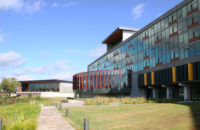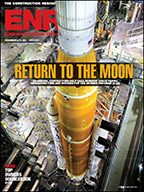At NASA's Kennedy Space Center in Florida, engineers and contractors are blasting through a roughly $100-million interior redo like no other. Removing, reengineering and replacing a big chunk of High Bay 3's "guts" from within the historic, 50-year-old Vehicle Assembly Building, or VAB—while at the same time making structural improvements to one of the largest structures of its kind in the world—is proving an epic undertaking for the builders delivering this giant leap in rocket assembly.
Driving the colossal rebuild is the need to better accommodate the nation's reemerging heavy-lift launch program, including NASA's new deep-space vehicle, called the Space Launch System (SLS)—which is similar in size to the Apollo/Saturn system that the VAB originally supported. The core challenge, though, is to engineer new assembly platforms with considerable vertical reconfigurability in support of not only SLS but other types of privately designed heavy-lift vehicles.
Therefore, for both practical and financial purposes, "We needed to have a design that enables us to be able to reconfigure the VAB without much of a construction effort, should there be any prospective government venture with a commercial contractor or a different government spacecraft," says Jose Lopez, NASA's senior project manager.
Platform Redo
Engineering new steel-framed platforms with nearly total reconfigurability—which the old systems completely lacked—would prove complex, due to the need to incorporate that mobility into the assembly structure's myriad support systems, such as gas lines and power and lifting and access equipment, says Lopez.
After NASA studied existing mobility-enabling technology that could be adapted for the project, such as that used on aircraft carriers, engineer RS&H began work on design. Hensel Phelps Construction is the project's general contractor.
Engineering systems that would meet NASA's functional requirements without overstressing the existing structure was a main challenge, says John Kercsmar, vice president with RS&H.
While the company has designed larger, similar platforms for other industries, the new High Bay 3 system is "very big" for movable systems, Kercsmar adds. The new assembly platform system features 10 different elevations, or levels, with each comprised of two halves, for a total of 20 halves. Each platform half measures approximately 76 ft wide, 38 ft deep and 6 ft high, with weights ranging between 144 and 168 tons.
Each level will be capable of repositioning vertically, in 1 ft increments, "providing a total vertical position range of nearly 350 ft from 77 ft in elevation to 424 ft in elevation," Kercsmar explained via email. Along with its vertical mobility, each level can independently extend and retract laterally. In all, the system provides about 5,000 sq ft of space for personnel and equipment, with most integrated commodities stowed under deck.
To further accommodate varying rocket geometries, RS&H and NASA agreed upon a design using removable and interchangeable platform structural inserts that could be customized for each particular vehicle. According to NASA, these inserts will measure in the area of 35 ft x 45 ft.









Post a comment to this article
Report Abusive Comment